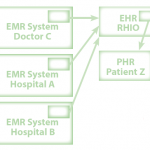At a recent meeting, one of my partners noted how good for patients and emergency physicians it would be if we could access medical records from the rival hospital system in town. It certainly would, but given the controversies between the big players (one giant system that includes hospitals, physicians and a major regional medical insurance provider, a secondary but still-big hospital-physician system, and a regional Blue Shield insurance company) I’m not going to hold my breath.
Part of the ARRA (American Recovery and Reinvestment Act of 2009) was to provide funding to develop electronic medical record (EMR) systems nationwide. Some of this money went to providers. Not emergency physicians, thankfully – if we were eligible for these dollars, we would all be individually responsible for developing and maintaining our own medical records systems, as opposed to using the hospital’s medical record system. Other money goes to hospitals that demonstrate meaningful use of EMR systems.
A portion of the ARRA money goes to support efforts to answer my partner’s plea: Regional Health Information Organizations (RHIOs). These are not supposed to be government entities, but rather some sort of public-private partnership. They are supposed to somehow derive a funding stream, and set up and maintain a Health Information Exchange (HIE) that will do just what my partner wanted – provide interchange between competitive rival hospitals. Coopetition is indeed a common model in the medical field, and there are over a hundred area in which RHIOs and HIEs are developing. But RHIOs are dying, too. One attempt to form a California RHIO failed in 2010, losing out to a competitor, and one in Pennsylvania failed in 2007.
I try to keep up with what’s going on with RHIOs and HIEs, but in my home state of Pennsylvania, it’s a bit difficult to find news of what’s going on. Perhaps due to the bitterness of the competition, western Pennsylvania doesn’t seem to have progressed as far as some other places. Or has it?
I should note that, as far as RHIOs and HIEs go, and indeed as far as medical informatics in general, I’m an amateur, a dilettante, an observer and commentator from the sidelines. Other than giving bits of advice here and there, and giving the odd lecture (sometimes very odd lectures), I no longer have any official position in the field of medical informatics. So my trying to find out about RHIOs and HIEs is basically as an interested member of the public.
So, today, trying to check up on what’s going on in Pennsylvania as regards RHIOs, I started searching the web. The Wikipiedia links above are a good place to start, they give a good overview. But in the section on “Other States” I found a link to the eHealth Initiative Directory. OK, I click on it, and “404 Not Found” – but I persist, and by typing in “http://www.ehealthinitiative.org/” I get to the eHealthInitiative page. Let’s see, it offers me membership – not clear how much that costs, and offers to sell me 2011 Report on Health Information Exchange: Sustainable HIE … Limited Time Deal Buy Sustainable HIE in a Changing Landscape and receive the Market Report and HIE Vendor List for free. Coupon Code is included within purchase ($250.). I guess it is good that they are trying to develop a funding stream…
I click on Directories, then Health Information Exchange (HIE), and then Interactive Map of All HIEs in United States. Clicking on Pennsylvania, I see a list of the HIEs in PA:
- Excela Health
- Geisinger Health System/Keystone HIE
- Northeastern Pennsylvania Health Information Exchange (NEPA HIE)
- Pennsylvania eHealth Collaborative
- Pinnacle Health HIE
- Southeast Pennsylvania HIE
- University of Pittsburgh Medical Center
- Vale-U-Health
- Vantage Holding Company
Each of these entries is a link. OK, I click on the first link. Oh, I see, this is restricted to members only; does it cost to become a member; hmm, it says “1 Year Paid Membership USD 26500.00.” Hmm, that’s if I have “Annual Gross Revenues of $25 million or more” Let’s see if there are other options; if I pick “Annual Gross Revenues less than $5 million” – which certainly fits me – then it will only cost me $2650.00 to see what this link leads to.
Looking at this list, I know that Excela, Geisinger/Keystone, Pinnacle, UPMC, Vale-U-Health are hospital systems with employed and affiliated physicians that allow access to their EMR for employees and affiliated physicians only. So not really a HIE in the sense of interoperability between different systems.
The Northeastern Pennsylvania HIE and Southeast Pennsylvania HIEs have no web presence, either on Wikipedia or on the first few Google search pages (except for news of the NEPHIE getting Federal money).
The Pennsylvania eHealth Collaborative has a web page, but if you click on any of the links, you either get another page where most of the graphics don’t load, or a “404 Not Found” error. Not the sign of a vibrant, thriving process.
Oh, yes, and Vantage Holding Company… I have no idea what this has to do with a RHIO or HIE. It looks like a holding company for many different things, some medical, some not. The first link on their website advertises document destruction, and I guess that if we’re going to all-electronic records that will be important. And I did find an address in the small town of Meadville, PA.
I regret to report that the day of the RHIO, at least in Pennsylvania, has not yet arrived.
Tags: Computers, Health Information Exchange, Healthcare, Healthcare IT, HIE, Information Technology, IT, Regional Health Information Organization, RHIO

